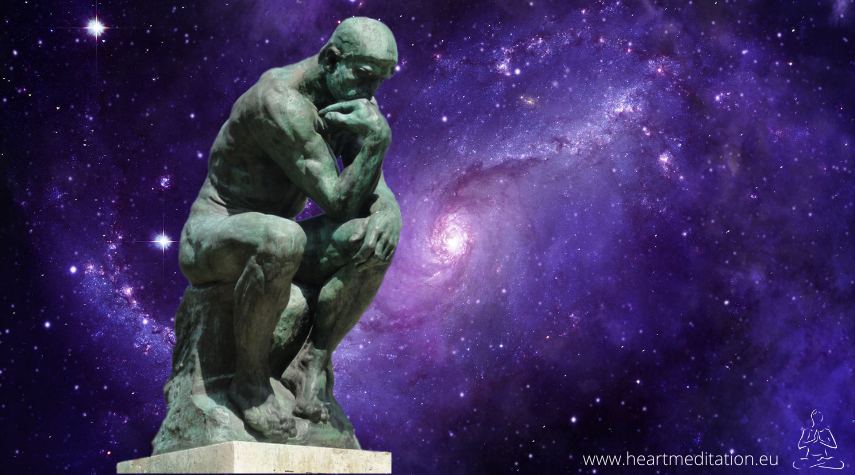CONSCIENCE AND CONSCIOUSNESS
Throughout history there have been many philosophers who have examined the concept of conscience like Socrates, and Emanuel Kant, just to name a few. Yet, the approach of spiritual masters, in particular Sufi masters, towards this topic often includes the points considered by philosophers; but also extends the concept to the person’s soul, or the person’s source of consciousness, through personal experiences that are a result of the evolutionary process known as spiritual evolution.
That is to say, for an advanced Sufi the concept of conscience is tightly connected to the phenomena which gives the Sufi their own awareness, meaning their soul or consciousness. However, this connection is one that is formed slowly, as a result of spiritual exercises, and is evolutionary in nature. It is precisely this evolutionary process that distinguishes a spiritual master’s approach from those of philosophers, even though along the way a spiritual seeker may come cross the many concepts that philosophers like Kant have eloquently discussed. This is because the start of the examination process of a person’s conscience is invariably the person’s power of reflection and introspective examination of one’s behaviour, which is a similar method that philosophers have used to examine moral and ethical behaviour.
Philosophical look at conscience & morality
Even though refection and self-examination are the starting points of this evolutionary process for a seeker, they are by no means the end of the process. As a seeker, through spiritual exercises, learns to examine their conscience through other means, like intuition, inspiration and even divine revelation, where guidance is received on the nature of the seeker’s behaviour from the higher consciousness itself. Thus, the viewpoints by which a seeker looks at the concept of conscience is always evolving, and indeed results in the evolution of the seeker, and how they relate to their soul, and ultimately to the Universal Consciousness itself.
Furthermore, when a spiritual seeker looks at the words of philosophers like Socrates the seeker actually sees some of the trait marks of such an evolution at times. As Socrates was also a spiritual seeker and not merely a philosopher. As he also famously based his own life’s purpose on self-examination, when he declared “the unexamined life is not worth living.” Which is also the approach a Sufi is taught by their teacher. Moreover, Socrates believed that Self-knowledge is a sufficient condition for a good life. Socrates also identified knowledge with virtue. Here, for a Sufi, self-knowledge is the knowledge of their soul and consciousness, which they begin to gain partly through examination of their behaviour and conscience, through a process of self-reflection known as Mohasebeh.
On the other hand, Emanuel Kant’s view of ethics and morality is more complex, and is often subject to misinterpretation. As Kant’s conception of conscience is a motivation theory set in the context of a reflection theory. Kant distinguishes conscience from moral principles and moral judgment, which are presupposed by it, but are identified with practical reason rather than with conscience. Kant seems to treat conscience under two main headings: (a) as one of the moral feelings presupposed by our susceptibility to duty; and (b) as a crucial aspect of a fundamental duty to ourselves, the duty of self-examination and self-knowledge as our own moral judge. Kant’s theory is definitely not a moral knowledge theory, since he regards conscience as being distinct from the faculty of moral judgment, which is the sole source of the moral knowledge that is to be implemented in the process of self-examination (and associated motivation) that is conscience. Therefore, Kant’s theory of conscience is the process of self-examination and self-judgment. Which is actually similar to the starting point of the Mohasebeh discipline the Sufi master teaches their student.
Sufism’s take on conscience
The first Sufi to set out the principles of Mohasebeh was Hasan Basri, who was a student of Ali Ibn-Talib, the spiritual heir of Prophet Mohammad, over a thousand years before Kant wrote his theory. Yet, what is also clear is that the principles of Mohasebeh which Hasan Basri describes are not fixed, as they evolve, as the student evolves. This evolution occurs in a stepwise manner under the guidance of qualified authorised teacher, who have themselves travelled the intricate path of spiritual evolution to reach their own essence and hence have attained the true Self-knowledge expressed by Socrates, through connecting their own consciousness to the Universal Consciousness.
In some ways the evolution of the seeker’s sense of conscience is analogues to the development of a weightlifter’s ability to lift weights. As initially, no weightlifter can lift 100kg weight at first attempt, but they develop this capacity by steadily and on a daily basis, lifting light weights to build their muscle strength, and then slowly shifting to lifting slightly heavier weights, until the day in the distant future they have built enough muscle strength to be able to finally lift the 100kg weight. This is indeed the same road taken by all Sufis in the development of their conscience, as they soon learn that their inner development is directly linked to the evolution of their intentions, thoughts and actions, which itself is an ever-narrowing path. For through this process, they realise that what was once seen as a good or commendable intention, thought and action is no longer sufficient or commendable in order to undergo further evolution. That is, they need to further improve their motivation, intention, thoughts and actions if they want to evolve further. All of which implies that they need to become more and more selfless. Therefore, at some point for an advanced seeker, what was once seen as commendable, will be regarded as lamentable – hence the narrowing of the path concept, which was mentioned earlier.
As true spiritual evolution starts when under the guidance of a true teacher, a student starts to examine their network of behaviour, and thus discover the roots of their behaviour, and then begins to modify their behaviour, so that they free their thoughts and behaviour patterns from the control of their ego. Alongside this process, the teacher provides the student with a set of spiritual exercises that establishes a union between the physical and metaphysical sides of the student, and also creates a connection between the soul of the student to its origin. This process is an endless one, as spiritual evolution is an endless process. As in reality it’s a path of union between a relative droplet, which is our soul, to an endless ocean of consciousness that is our origin. Yet, in this journey, with every step the student’s connection grows, as well as their love and respect for all forms of manifestation of the ocean of existence, in all dimensions of existence! This is indeed the process undertaken by all true spiritual masters of all paths who have ever lived! That is why the 13th Century Sufi master Saadi in his poem states:
Do not irritate even an ant in its work,
For it possesses a sweet life, which it cherishes.
This evolutionary process for a seeker’s conscience is an important point, which makes the process adaptable and attainable for seekers of all levels. As it caters to all levels of ability, while slowly encouraging each person to higher and higher conscionable behaviour, in a methodical and stepwise manner.
Thus, the process of Mohasebeh is a very flexible approach that enables all seekers to grow at their own pace and is also initially very simple to adopt into one’s life. As it’s a process undertaken initially by a novice once a day. Where a seeker, through Mohasebeh, slowly recognises the facets of their ego in their life, and slowly through deep reflection and analysis, learns to control their ego. As each student is asked to sit in a quiet place at the end of their day and write down all their activities and interactions with everyone they have encountered. Then, carefully write down those interactions, and group them into various categories, based on their impact on themselves, and all those they have encountered.
Each student’s aim through Mohasebeh, is to create two main groups of categories of thoughts and actions. The thoughts and actions that produced positive impact on society, and on their evolution, and also list those thoughts and actions that have had a negative impact on society, and their evolution. The students are then asked to further subdivide these two main categories. For example, the negative groupings of actions could be subdivided further into those thoughts and actions that stemmed from anger, greed, jealousy etc. While, positive classes of thoughts and actions could be subdivided further into groupings like kindness, compassion, empathy, etc.
Then the students are asked to count the occurrence of each thought and action, within each subcategory, and then focus on reducing the most frequent negative traits in their behaviour, and also increase the least frequent traits in their positive behavioural subgroupings. Then, move to the next respective categories. As they are taught, through this process they would slowly create inner balance within their behaviour and thought patterns, which will slowly allow them to control their egos.
In the process, it is also important for each student to know that the judge in this process is their own conscience, and they should never judge anyone else. As this is a method of deflection that their ego often uses, to distract them from their task of reining their ego.
As in effect when they start to write down their thoughts, and actions, on a daily basis, and categorise them, what they are doing, is actually mapping their behavioural patterns, in black and white! So what was previously hiding in the depths of their subconscious, through this process it will slowly reveal itself! This is a key point. As only when this pattern is staring in one’s face in black and white, that a person stands a chance of reining their ego! Otherwise, for the rest of their lives, it will likely control them through hiding its many faces!
This principle is demonstrated by the following Sufi story:
Where one day, a Sufi, on seeing a village crowd gathered around an old man walking his grime covered dog on a leash, hurling abuse and condemning the old man, approached the mob and asked them why they were heaving abuse at the old man.
In response a man, while shouting abuse at the old man replied, “We are shouting at this man for bringing his old, unclean dog into our village, as we don’t want him or his unclean animal amongst us!”
The Sufi on hearing the man stepped in between the group, and the old man, and said, “But this old man is my teacher. Have you not heard we must all respect our teachers?”
One of the group in reply cried out “You are a liar, as he can’t be your teacher, as you have only just seen this man!”
The Sufi smiled and retorted, “No my dear man, I am no liar, and it’s you who are mistaken. As this old man who is walking his dog on a leash is a teacher for us all. As he has learned the skill of controlling his animal and keeping it on a leash. While all of us, including myself, not only have not fully recognised our inner animal, but we often let it control us. As it’s often this inner animal that has our sense of reasoning, and our very soul on its leash! So I suggest before you complain about the uncleanliness of this dog, you try to clean your inner state, as it is that state that will determine your eternal homeland!”
Sufism’s experiential view on conscience and consciousness
A Sufi gains further clarity about their sense of conscience when they undertake the step to further subdivide the above-mentioned groupings, and drill down towards the underlying causalities of their behaviour, starting from the observations of the daily symptoms that one spots during one’s Mohasebeh. So through this process, the seeker slowly becomes a physician of their own soul, as the seeker discovers the cure for their own malaise, and eventually when they have mastered their ego they become a physician for all other souls. In practical terms, this occurs when the seeker has advanced to a level of mastery of their ego and have managed to connect their soul to the Universal Consciousness and have attained the station of Nirvana or Fana (annihilation) in Sufi terminology!
What is more, through this process, the seeker also understands the nature of their own consciousness and how it relates to their sense of conscience. As the spiritual seeker, during this evolution, begins to understand the multilevel nature of their consciousness. That is, they realise that the phenomenon that gives them their awareness, which is commonly referred to as their soul, has physical interfaces that give it access to, and allows it to interact with, the physical world, but it also has hidden levels which are purely metaphysical.
The aforementioned mentioned physical interfaces are of three types: Paleocortex (the old animal brain which we share with other animals on the planet), the Neocortex (which is our new brain and the centre of our rational reasoning, logic and analysis), and our heart.
The Paleocortex, which is responsible for our autonomous functions like breathing, digestion etc. is also the centre of the person’s ego. While the Neocortex is the centre of our rational reasoning, which in most humans, during their lives, becomes deeply connected and controlled by our ego or Paleocortex. So this is why the initial stages of Mohasebeh are centred on identifying these connections and pathways, and then slowly rewiring these pathways in order to lead to different behaviour or feedback loops that are responsible for the person’s character. So this process is a type of reprograming that relies on our brain’s neuroplasticity to make new pathways and neuro-connections.
However, these connections that ultimately determine the person’s character and allow the spiritual evolution to continue are not limited purely to neuropathways. As slowly, by developing an ever-deeper channel between their heart and their brain, the seeker is able to connect their sense of conscience to the metaphysical sides of their soul. As the person’s heart is a gateway to the metaphysical dimension of the person’s soul. When this connection is established and is developed slowly, the analysis of the person, during their life or in their Mohasebeh is no longer just based on the inputs they receive via their physical five senses. As they slowly gain access to the input they receive from their five inner senses, which are the senses of their soul. It is then through intuition, inspiration and revelation and other means of communication that they then start to receive input about the world and other dimensions that their soul has become connected to, as a result of their spiritual exercises.
Thus as a result, a Sufi is no longer a single dimensional being or a person locked into the four dimensions which is referred to as space-time. As a Sufi slowly becomes a truly multidimensional being. For they gain limited access to the information from other dimensions through intuition, inspiration and other means, during their normal awareness, or even wider access during a deep meditative state.
As a result of this evolution, the seeker is no longer just using the light of rational analysis to shine light on their ego and behaviour, for they slowly learn to use an even more powerful light source in their analysis. Which ultimately leads them to have the ability to shine the light of their own soul on the matter, and in their Mohasebeh. It is through this light they are able to navigate ever narrowing pathways of spirual evolution, which is the endless journey of a seeker towards the perfection that is the Universal Consciousness!
Consequently, even though a Sufi, through Mohasebeh, may initially encounter some of the steps, and even stages of ethics and morality mentioned by philosophers such as Kant; they will soon, through their evolution, surpass these stages to the point that the actions and guidance they receive is no longer limited to what philosophers have mentioned, but instead becomes guided by the Universal Consciousness itself.
From this experience a spiritual seeker will have the direct realisation that their own essence and the whole creation invariably are interconnected to the same Reality, and it’s from this perspective that they see and respect the whole creation. It is from this viewpoint that Saadi famously said:
Human beings are members of a whole,
In creation of one essence and soul.
If one member is afflicted with pain,
Other members uneasy will remain.
If you have no sympathy for human pain,
The name of human being you cannot retain.
So for Saadi the very definition of human being is based on a person’s sense of empathy for others!
As a result of this evolutionary process the seeker finally is able, through personal experiences, to understand the relationship between their conscience and consciousness, and unleash their inner aptitudes of their soul, which they were unaware of before their spiritual evolution, and also enable other seekers to reach the same realisation!
The lessons for our society’s development
Given the many challenges that humanity faces in the twenty-first century, it is clear that one of the effective ways that social cohesion can be attained is through the above-mentioned approach to social conscience. Where the society’s communal conscience, is developed on an individual basis through teaching the important spiritual principles, like Mohasebeh, as part of a wider educational movement. For as the French novelist Andre Malraux said: “the 21st century will be spiritual or won’t be!”
Especially, as we see the tentacles of egoistic behaviour everywhere in our global community, whether it be in regard to environmental issues, economical inequalities, social injustices or human rights. One of the ways we can raise the global conscience of humanity is to try to develop each individual’s sense of conscience, which invariably requires a grass roots movement of education that is based on spiritual exercises like Mohasebeh.
Yet, this approach should not be seen as a theistic approach, as it requires no beliefs nor doctrine. As it is a matter of personal experience, through a set of personal exercises under the guidance of a qualified teacher. For the exercises themselves slowly bring about certitude for each individual about their own reality and require no prior set of beliefs. For as they say, the proof of a pudding is in tasting it.
In this regard a seeker like a Sufi, is purely a gnostic scientist, who should be seen as a scientist carrying out a scientific experiment in a sterilised laboratory. In this context, the laboratory in question is the person’s own body and the subject of examination is the person’s sense of conscience and the phenomenon that give the person their awareness. Furthermore, the sterile nature of the laboratory in this example, refers to the cleansing of the seeker’s mind from all superstitions, preconception, and misconceptions. So that the seeker can freely and clearly interpret their own experiences about the nature of their own reality.
In this way, each person can walk an experiential path towards inner enlightenment, where they can unify the subject and object of their study on arrival at the point of nirvana or Fana. Thus, slowly on an individual basis, each person can learn to control their egos and be part of collectively building a cohesive society, where the collective conscience of the society is raised to a higher level. This is indeed the paradigm shift hinted by Andre Malraux, as the key for the survival of humanity in the 21st Century! As when we have successfully freed a large section of humanity from their egoistic mind-set, problems like global poverty, hunger and other issues become more manageable. For we will not see one group, constantly in pursuit of the control of wealth and resources at the expense of another, in an endless fashion. Otherwise, we will keep seeing the problems of history repeating themselves over and over again.
Therefore, the escape from repeating the tragedies of history, and global problems, is invariably interlinked with how each of us, as individuals, are willing to undertake the steps explored above, in terms of freeing ourselves from the clutches of our egos, through the unification of our sense of conscience with our own consciousness!






